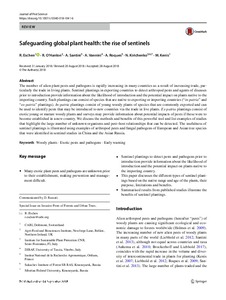Показать сокращенную информацию
Safeguarding global plant health: the rise of sentinels
| Автор | Eschen, R. | |
| Автор | O’Hanlon, R. | |
| Автор | Santini, A. | |
| Автор | Vannini, A. | |
| Автор | Roques, A. | |
| Автор | Kirichenko, N. | |
| Автор | Kenis, M. | |
| Дата внесения | 2019-07-01T07:26:47Z | |
| Дата, когда ресурс стал доступен | 2019-07-01T07:26:47Z | |
| Дата публикации | 2018 | |
| Библиографическое описание | Eschen, R. Safeguarding global plant health: the rise of sentinels [Текст] / R. Eschen, R. O’Hanlon, A. Santini, A. Vannini, A. Roques, N. Kirichenko, M. Kenis // Journal of Pest Science. — 2018. | |
| ISSN | 16124758 | |
| URI (для ссылок/цитирований) | https://doi.org/10.1007/s10340-018-1041-6 | |
| URI (для ссылок/цитирований) | https://elib.sfu-kras.ru/handle/2311/110832 | |
| Аннотация | The number of alien plant pests and pathogens is rapidly increasing in many countries as a result of increasing trade, particularly the trade in living plants. Sentinel plantings in exporting countries to detect arthropod pests and agents of diseases prior to introduction provide information about the likelihood of introduction and the potential impact on plants native to the importing country. Such plantings can consist of species that are native to exporting or importing countries (“in-patria” and “ex-patria” plantings). In-patria plantings consist of young woody plants of species that are commonly exported and can be used to identify pests that may be introduced to new countries via the trade in live plants. Ex-patria plantings consist of exotic young or mature woody plants and surveys may provide information about potential impacts of pests if these were to become established in a new country. We discuss the methods and benefits of this powerful tool and list examples of studies that highlight the large number of unknown organisms and pest–host relationships that can be detected. The usefulness of sentinel plantings is illustrated using examples of arthropod pests and fungal | |
| Тема | Woody plants | |
| Тема | exotic pests and pathogens | |
| Тема | early warning | |
| Название | Safeguarding global plant health: the rise of sentinels | |
| Тип | Journal Article | |
| Тип | Journal Article Preprint | |
| ГРНТИ | 68.37.05 | |
| Дата обновления | 2019-07-01T07:26:47Z | |
| Институт | Институт экологии и географии | |
| Подразделение | Лаборатория биогеохимии экосистем | |
| Журнал | Journal of Pest Science | |
| Квартиль журнала в Scopus | Q1 | |
| Квартиль журнала в Web of Science | Q1 |

